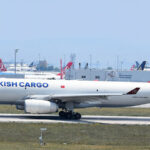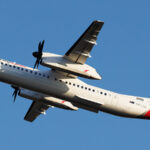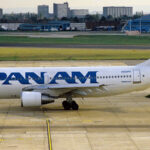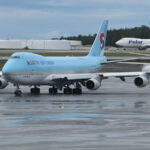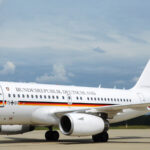o Doug Christensen, a one-stop-shop for shippers includes a ticket overseas. That may not sound like news to many air freight companies, but considering that Christensen’s bosses at USFreightways have their history more closely tied to interstate highways than international flight paths, it’s downright revolutionary. The Chicago-based less-than-truckload carrier is one of many American truckers branching out beyond services that have traditionally been restricted by the height and width of their trailers.
The truckers are setting up new divisions, making acquisitions, setting up partnerships and doing anything else they can to get into the international air forwarding business, all of it because they say that’s where their best customers are going. To many of them, logistics is nirvana, and air is the only way to get there.
“The world is globalizing and you have to get with it,” says Christensen. “It’s time to step into the global arena.”
“Less-than-truckload companies can’t continue to operate the way they did five to six years ago,” says Ernie Valdez, director of the new international business unit of regional LTL carrier Averitt Express. “You have to be a total solutions provider. … We don’t want to pigeonhole ourselves.”
On the other side, the air freight forwarders that are already coping with accelerating consolidation now see big trucks bearing down on them. Experts say the competitive threat is especially alarming to small- to mid-size air freight providers who are already squeezed by larger air-focused competitors and the spreading time-definite domestic services of regional truckers.
Air providers receive less than 5 percent of the spending on cargo transportation by American shippers. Truckers account for 80 cents of every dollar, and they believe they can add to that share and rake in the higher yields air services typically bring.
“I think the truckers can do it,” says Greg Smith, global segment manager for freight and logistics at IBM. “They have the customer base. They certainly have the operating knowledge. The question is, can they diversify their product base? I think they can.”
The U.S. trucking industry’s push into freight forwarding territory is hardly new. It grew after trucking was deregulated in 1980 and the trend picked up speed in the mid-1990s as truckers tired of watching top customers turn their most urgent shipments to air providers. At the same time, a new generation of regional surface operators sharply stepped up expedited ground services, offering delivery guarantees for regional hauls well below the cost of air service.
By cutting coast-to-coast transit time to as little as three days and dedicating trucks to expedited door-to-door service, truckers of all sizes have eaten into air freight trade. The providers claim the services have been added at the request of customers, but trucking executives clearly like the higher yields.
“Yellow is really putting a lot of focus on higher margin business, and air is one component of it,” says Peter Brown, president of Yellow Global, a young division of Overland Park, Kans.-based Yellow Corp., one of the nation’s top three LTL carriers.
But until recently, most truckers’ air forwarding business has been sold on an occasional and spot basis. By establishing separate freight forwarding divisions with offices throughout the world, the trucking companies hope to turn air freight from a small sideline business into a routinely used service that boasts a network capable of handling large accounts. Even higher profits await if the new air services, along with other new international products, lead to single-source contracts.
“You can only get so much efficiency out of one warehouse or one truck,” says USF’s Christensen.
And by almost all accounts, the time to make the push is now. Consolidation has left many forwarders looking to poach each others business. Forwarders large enough to handle the big multinational accounts are restructuring their networks and many that aren’t are focused on whether they are going to acquire another company or positioning to be acquired themselves. That leaves sales teams distracted, some say, and an environment ripe for new entrants.
“Right now things are good in the fright forwarder market and there’s a lot of shake-out,” says Patrick Brady, senior vice president of Consolidated Freightways, the Menlo Park, Calif.-based LTL giant.
“What’s changed has been very consistent with our business model and evolving strategy,” says Jack Edwards, chief executive officer of World Point Logistics, a recent startup hoping to quickly forge a global network of air forwarding. “Companies want door-to-door and they want multimodal capabilities.”
Of course, shipper demands can cut two ways and that’s why the trucking move into air business is also a defensive maneuver, a shift to higher-margin business in the face of profit-killing rate competition and declining returns of plain-vanilla LTL traffic.
The move upstream can be far more rewarding for the truckers than a move to lower-yield business would be for forwarders, say experts. “Those at the high end of the business have a much harder time adding business then those at the lower end,” says Smith.
Second, a trucking network is more difficult to match. “The most difficult thing to get you arms around is the U.S. truckload market because there’s 400,000 lines in the U.S.,” says Barry Butzow, senior vice president of C.H. Robinson, a trucking-focused third-party provider also trying to expand into other modes and international logistics.
By comparison, some argue that becoming a freight forwarder is about as easy as opening a travel agency. “What they do is something anybody else can do,” says Robert Schirmer, president of RAS Associates International, a consulting firm. “You just have to register to be a forwarder. I can be one tomorrow if I want.”
Winning high-stakes international freight business isn’t as easy as registering, however, regardless of the customer base and transportation expertise. And although most large domestic truckers are after that business, they don’t agree on how to find it.
Launched into forwarding with the purchase of mid-sized domestic forwarder Seko Air Freight a couple of years ago, USF prefers the Big Bang approach.
USF has quickly established 18 offices in Asia and is on the cusp of several acquisitions in Europe. It’s after international business from the largest of the multinational shippers, in particular large U.S. retailers that already spend about $50 million apiece annually with USFreightways.
“Our position with them is far greater than any international forwarder,” says Christensen. “We’re going to mirror the international flow with the domestic flow. … That’s where the opportunity is – to marry the flows.”
Rival Yellow believes it has a better shot at gaining international business from its mid-size customers, particularly those in the heartland, where Yellow Freight’s trucking network gives it operational leverage.
“Yellow Freight does significant business with almost every company in the U.S. at some point during the year,” says Brown. “(But) at this point in our growth we’re looking at the middle companies.”
Yellow also isn’t hunting for international acquisitions, preferring to stick with agent relationships. “We have no intentions to buy companies or open up offices outside the U.S.,” says Brown.
Yellow Global is instead looking at acquisitions in North America and expanding its domestic air forwarding network, which is now limited to nine offices. In that regard, Yellow is a couple of years behind USF, which ramped up its U.S.-based forwarding network quickly through acquisitions and has already opened forwarding offices in such secondary markets as Tulsa, Okla. Freight forwarding accounts for 10 percent stake of the company’s revenue stream and that should rise as USF pushes into Europe and Latin America.
“We’re getting global in a hurry,” says Christensen. “We’ll have an infrastructure as large as Expeditors (International of Washington) in six months and we’ve done it a lot cheaper.”
The comparison to one of the largest U.S. international forwarders is obviously bluster, but USF’s cash reserves and its expansion strategy are winning kudos from Wall Street.
“I think they’re doing absolutely the right thing,” says Gregory Burns, a New York-based transport analyst with Lazard Fréres. “They seem to be deploying their cash flow from their highly profitable trucking business into areas that have higher growth and probably higher margins down the road.”
Burns calls USF, along with CNF Transportation, which was split apart from CF in 1996, “the leaders of the trucking companies pushing into the forwarding arena.”
CNF’s trucking subsidiary, Con-Way Transportation Services, accounts for less than a third of the company’s overall revenue. CNF’s Emery Worldwide and fast-growing Menlo Logistics subsidiaries combine to account for well over a half of the company’s $5 billion-plus annual revenue stream.
For now, Yellow Global contributes just a sliver to its parent company’s top line and it will probably be a couple of years until it even reports its results separately. The unit was introduced in June 1998 as YCS International and won Cargo Network Services certification as a forwarder only in January.
“We’ve moved the needle considerably but we have a long way to go,” says Brown, former president of LEP Profit. “Yellow is a $3 billion company. We’re just a flea on the dog, literally. But we’re on the right track.”
Most trucking companies are just starting down the path to one-stop provider status and have little to show to support their rhetoric.
CF, for example, recently made its first serious push at diversifying since it split from CNF. In June, the trucking giant acquired Minnesota-based FirstAir and re-established CF Airfreight 11 years after the original company folded into Emery Worldwide.
FirstAir was a small, largely domestic forwarder with a handful of offices. It is a frame designed to build on however, and the company plans to add 40 forwarding offices in North America over the next two years. It has international offices on the drawing board along with high hopes for multinational accounts.
“Yes, we’re going after that, and yes, it’s difficult to sell,” says Brady. “But CF Airfreight has a very bold expansion plan … and FirstAir will benefit from the rebranding. The red and green on their business cards will get people into a lot more offices.”
Brady added that CF Airfreight will focus on shippers based at or near the largest gateways, although he acknowledges that the rural businesses among CF’s 400,000 customers are most likely to turn their international movements over to CF.
Even some regional motor carriers aren’t limiting themselves to small-volume international shippers as they expand into freight forwarding. Tennessee-based Averitt Express launched its international unit in July and has only handled domestic air freight since March. But while Valdez thinks he can exploit Averitt’s trucking infrastructure in the rural southeast, he also plans to compete with the largest forwarders at the region’s major air hubs.
“The trucking infrastructure is definitely an advantage over a forwarder who doesn’t have an office in a rural area,” he says. “(But) we are also targeting companies that are large exporters. We’re not going to do it halfway.”
Averitt International is even looking at winning shippers overseas.
But the company has only just started looking for foreign agents and isn’t planning to invest in acquisitions and new offices abroad. “I’m not that naive; our bread and butter is small and mid-size companies,” says Phil Pierce, Averitt’s executive vice president of sales and marketing. “This is an export product. We’ll be bringing in the imports later this year. We’re a small player, but we don’t expect to stay this size.”
The company already has a handful of small feeder planes in its stable and has been quietly looking at the air freight market even as it has stepped up its expedited trucking services this year. Larger expansion would for privately-held Averitt likely require an investment infusion from outside, however.
Indeed, the investment required for air services, even those that are supposedly non-asset-based, can be a cold slap for companies used to financing large-scale fleet overhauls with relative ease.
Convinced agents and alliances abroad won’t suffice over the long run, CF plans to take on additional debt to fund international acquisitions. And to raise the cash needed to broaden its services and geographic coverage, Schneider National is spinning off its logistics division. The company is planning a public offering of Schneider Logistics late this year or early next year, a bold move for the privately-held company that suggests the weight international logistics carries in the global marketplace.
The cash could pave the way for acquisitions that will give Schneider the international network needed to compete with its more diversified publicly-backed competitors.
And as the race to build international networks gains steam, those relying on partnerships abroad could find themselves precluded from single-source provider competitions. That’s certainly the hope at C.H. Robinson, which over the last decade has established 22 offices abroad.
“We want to be totally responsible for the total pan-continental pickup and delivery,” says Butzow. “What it gives the customer is a single point of contact from door-to-door.”
C.H. Robinson’s diversification since its 1997 initial stock offering may provide a glimpse into the future. “The (recent) development of air has been the direct correlation of the customer’s confidence in us and the other modes we perform. When we go to a customer the drive is multi-mode,” said Butzow.
But after 10 years of European operations, C.H. Robinson still handles 20 times more freight in the U.S. than in Europe, and the company is just getting started in Asia and South America. That leaves hardly an international success story to date among U.S.-based trucking companies and a lot of industry veterans wondering if they will ever pose a serious challenge to top international forwarders.
“I haven’t seen a lot of companies actually achieve that strategy,” says WorldPoint’s Edwards.
“It’s darn near impossible,” says Vincent Chin, a freight forwarding industry analyst with Merrill Lynch. “They don’t have the infrastructure or network to do it efficiently or profitably. … I don’t think they’ll be able to provide a high level of service.”
Air freight operators warn that there is a deep chasm between the cultures of the two modes and that truckers who are used to living by predictable, if not entirely dependable, networks may be shocked at the free-wheeling nature of international air freight shipping.
“It’s messier, you have a lot to contend with (and) you have more variables,” says David S. Quin, managing director of Emery Worldwide’s expedited division. “It’s not just picking up a shipment and delivering it with a hot-shot truck.”

